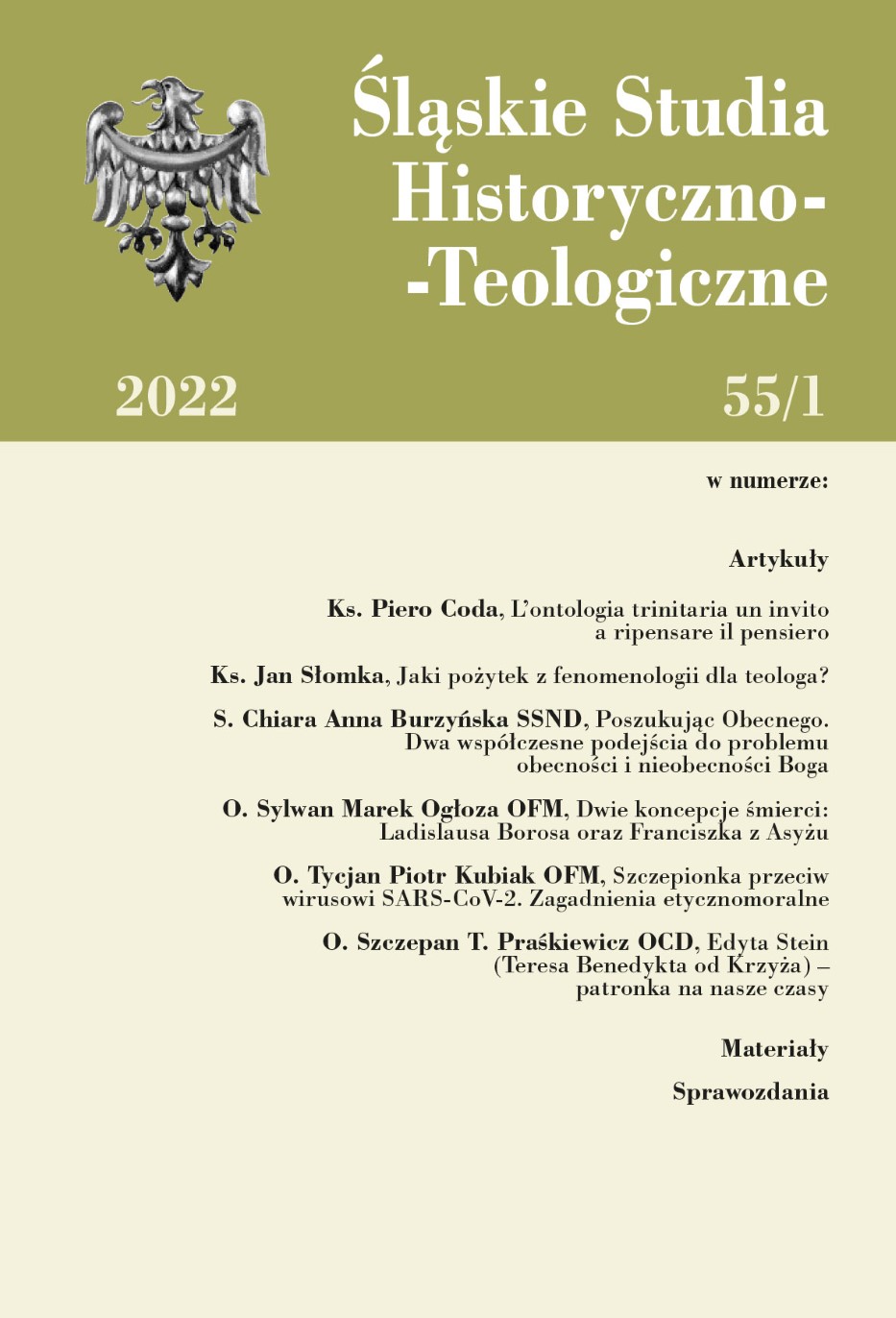

 https://doi.org/10.31261/SSHT.2022.55.1.05
https://doi.org/10.31261/SSHT.2022.55.1.05
Społeczeństwo żyjące we współczesnym świecie jest świadkiem ciągłych przemian, które dokonują się w przestrzeni życia jednostek i społeczeństw w ujęciu globalnym. Zmiany te niosą tak pozytywne jak i negatywne skutki dla ludzkości. W ostatnich dwóch latach świat został doświadczony przez pandemię koronawirusa SARS CoV-2, która pozbawiła życia 2,4 mln ludności. W obliczu pandemii rozpoczęto pracę nad stworzeniem szczepionki, która będzie antidotum na zaistniały kryzys.
Artykuł przedstawia zagadnienia związane ze szczepionką, która została wprowadzona do powszechnego obiegu z końcem 2020 roku. Pomimo entuzjazmu jaki został wywołany powstaniem w szybkim tempie szczepionki, istnieją zagadnienia, które wskazują na niedoskonałość otrzymanego produktu. Rodzące się pytania są związane z skutkami ubocznymi, które może powodować niezbadany dokładnie preparat oraz z samym procesem jego powstawania. Niniejszy artykuł ukaże także stanowisko Kościoła katolickiego w omawianej kwestii.
Pobierz pliki
Zasady cytowania
Licencja

Utwór dostępny jest na licencji Creative Commons Uznanie autorstwa – Na tych samych warunkach 4.0 Miedzynarodowe.
Właściciele praw autorskich do nadesłanych tekstów udzielają Czytelnikowi prawa do korzystania z dokumentów pdf zgodnie z postanowieniami licencji Creative Commons 4.0 International License: Attribution-Share-Alike (CC BY-SA 4.0). Użytkownik może kopiować i redystrybuować materiał w dowolnym medium lub formacie oraz remiksować, przekształcać i wykorzystywać materiał w dowolnym celu.
1. Licencja
Wydawnictwo Uniwersytetu Śląskiego zapewnia natychmiastowy otwarty dostęp do treści swoich czasopism na licencji Creative Commons BY-SA 4.0 (http://creativecommons.org/licenses/by-sa/4.0/). Autorzy publikujący w tym czasopiśmie zachowują wszelkie prawa autorskie i zgadzają się na warunki wyżej wymienionej licencji CC BY-SA 4.0.
2. Oświadczenie Autora
Autor deklaruje, że artykuł jest oryginalny, napisany przez niego (i współautorów), nie był wcześniej publikowany, nie zawiera stwierdzeń niezgodnych z prawem, nie narusza praw innych osób, jest przedmiotem praw autorskich, które przysługują wyłącznie autorowi i jest wolny od wszelkich praw osób trzecich, a także, że autor uzyskał wszelkie niezbędne pisemne zgody na cytowanie z innych źródeł.
Jeśli artykuł zawiera materiał ilustracyjny (rysunki, zdjęcia, wykresy, mapy itp.), Autor oświadcza, że wskazane dzieła są jego dziełami autorskimi, nie naruszają niczyich praw (w tym osobistych, m.in. prawa do dysponowania wizerunkiem) i posiada do nich pełnię praw majątkowych. Powyższe dzieła udostępnia jako część artykułu na licencji „Creative Commons Uznanie autorstwa-Na tych samych warunkach 4.0 Międzynarodowe”.
UWAGA! Bez określenia sytuacji prawnej materiału ilustracyjnego oraz załączenia stosownych zgód właścicieli majątkowych praw autorskich publikacja nie zostanie przyjęta do opracowania redakcyjnego. Autor/autorka oświadcza równocześnie, że bierze na siebie wszelką odpowiedzialność w przypadku podania nieprawidłowych danych (także w zakresie pokrycia kosztów poniesionych przez Wydawnictwo UŚ oraz roszczeń finansowych stron trzecich).
3. Prawa użytkownika
Zgodnie z licencją CC BY-SA 4.0 użytkownicy mogą udostępniać (kopiować, rozpowszechniać i przekazywać) oraz adaptować (remiksować, przekształcać i tworzyć na podstawie materiału) artykuł w dowolnym celu, pod warunkiem, że oznaczą go w sposób określony przez autora lub licencjodawcę.
4. Współautorstwo
Jeśli artykuł został przygotowany wspólnie z innymi autorami, osoba zgłaszająca niniejszy formularz zapewnia, że została upoważniona przez wszystkich współautorów do podpisania niniejszej umowy w ich imieniu i zobowiązuje się poinformować swoich współautorów o warunkach tej umowy.
Oświadczam, że w przypadku nieuzgodnionego z redakcją i/lub wydawcą czasopisma wycofania przeze mnie tekstu z procesu wydawniczego lub skierowania go równolegle do innego wydawcy zgadzam się pokryć wszelkie koszty poniesione przez Uniwersytet Śląski w związku z procedowaniem mojego zgłoszenia (w tym m.in. koszty recenzji wydawniczych).

Tom 55 Nr 1 (2022)
Opublikowane: 2023-10-05

Utwór dostępny jest na licencji Creative Commons Uznanie autorstwa – Na tych samych warunkach 4.0 Miedzynarodowe.